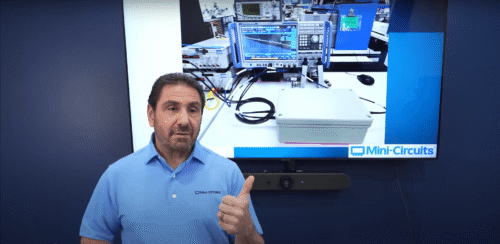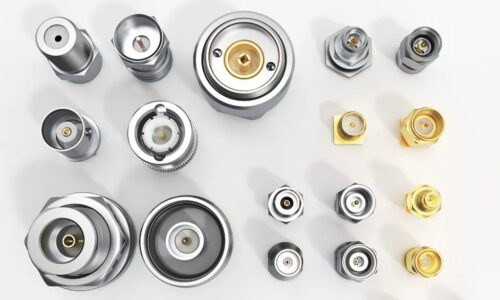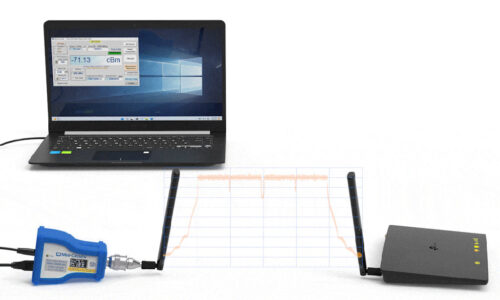MMIC Amplifiers Stretch the Boundaries of Dynamic Range in VHF/UHF Communications
Radha Setty, Guangyue He and Brandon Kaplan, Mini-Circuits
MMIC Amplifiers: Current Limitations below 2 GHz
The noise figure and linearity of low noise amplifiers are critical factors in maximizing sensitivity and dynamic range in RF receiver design. The amplifier noise figure determines the weakest signal the amplifier can discern, and the IP3 determines the degree to which intermodulation products from nearby signals interfere with the desired signal. The lower the noise figure and the higher the IP3 of the amplifier at the receiver input, the greater the sensitivity and Spurious Free Dynamic Range (SFDR) of the receiver.
Today, the market availability of single-function MMIC LNAs with high dynamic range is concentrated around the ISM frequency bands between 2 GHz and 6 GHz. These amplifiers are predominantly PHEMT or HBT designs on GaAs, and both come with inherent advantages and drawbacks. HBT designs are capable of achieving very wide bandwidths and excellent power density with saturated output power up to 1W through about 6 GHz. However HBT designs generally aren’t conducive to low noise, typically achieving about 3 dB noise figure at best, making them unsuitable for receivers where higher sensitivity is required.
PHEMT designs are capable of realizing noise figures below 1 dB and IP3 above 40 dB but existing approaches are limited in frequency coverage to roughly 40 MHz and above. External matching networks and feedback can be applied to extend coverage down to 1 MHz, but this has been known to degrade noise figure performance. While PHEMT designs generally provide outstanding noise figure performance and very high IP3 for popular wireless applications from Wi-Fi (2.4 GHz) through WLAN (5.6 GHz), options for applications below 2 GHz almost invariably sacrifice noise figure performance, leaving the densely utilized HF, VHF and UHF application bands from 3 to 2000 MHz underserved.
MMIC amplifiers currently on the market within the HF/VHF/UHF region are limited by noise figure performance no less than 2 dB. This limitation has been a barrier to receiver performance in lower frequency applications. Breaking through that barrier would require a MMIC amplifier with the holy trinity of low noise, high IP3, and multi-octave frequency range without multiple, band-specific matching circuits.
Raising the Standard for Combined Performance
To better support system designers working at the lower end of the frequency spectrum, Mini-Circuits developed a new series of MMIC amplifiers utilizing 0.5 micron E/D mode PHEMT process on GaAs, spanning bandwidths as wide as 1000:1 from 1 MHz up to 2 GHz. These designs employ a proprietary architecture enabling good matching down to 1 MHz without any band-specific matching circuits, which is highly unique for PHEMT designs.





These amplifiers raise the industry benchmark for combined performance, combining all the key features for broadband, high-dynamic range receivers in the HF, VHF, and UHF application bands:
- They are well matched for 50Ω without any band-specific matching circuits required.
- They offer reasonably flat gain, typically within ±5 dB or better across a 1000:1 bandwidth, reducing the need for equalizers and other gain flattening techniques.
- The model family gives users the choice between 3-5V operation to minimize power consumption and 8V operation, which enables IP3 performance up to +45 dBm
- All models provide outstanding noise figure across their operating bandwidths, as low as 0.8 dB for the low voltage versions, and no greater than 1.4 dB for the high voltage versions.
Beyond RF performance, thermal efficiency has become an increasingly important consideration as receivers get smaller and smaller. Denser layouts mean that radios are running hotter, and components need wider thermal range for reliable operation. PHA-series amplifiers come housed in SOT-89 packages with extremely low thermal resistance of 23°C/W from junction to ground lead, allowing them to operate well below maximum junction temperature in operating environments up to 105°C for the 3-5V models and 95°C for the 8V versions.

The units have undergone life test at 160°C junction temperature for 3600 hours at the time of writing, and will be qualified up to 5000 hours (the industry standard for HTOL is 1000 hours at 125˚C junction temperature). Their outstanding thermal range and reliability at high temperature makes these models an ideal candidates for densely populated miniaturized radio applications. Furthermore, the amplifiers can deliver up to 20 dB gain at 1000 MHz in a single stage minimizing the impact of following stages on system Noise Figure, which also reduces component count, saves board space, and reduces overall system size.
Conclusion
The low end of the frequency spectrum from HF through UHF is densely allocated for applications ranging from military communications to broadcast, avionics, TV, amateur radio and more. There isn’t a single piece of spectrum that’s unused from 3 to 2000 MHz. The availability of amplifiers currently on the market for these applications is limited with respect to noise figure, IP3 and bandwidth.
Mini-Circuits’ PHA-series provides a solution to existing limitations for these applications by providing the low noise, high linearity, high reliability and wide fractional bandwidth needed to improve performance in VHF/UHF receivers. The wide bandwidth of these amplifiers means that a single device can be used across the multitude of applications in this range, and their exceptional IP3 makes them suitable for keeping intermods down in crowded signal environments. Meanwhile the significant reduction in noise figure compared to existing options in this range represents a new capability for designers and opens up many possibilities to improve receiver performance in a wide range of applications.











